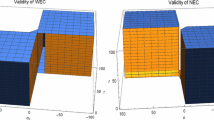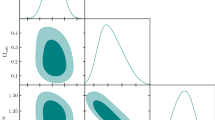Abstract
This paper analyses the cosmological consequences of a modified theory of gravity whose action integral is built from a linear combination of the Ricci scalar \(R\) and a quadratic term in the covariant derivative of \(R\). The resulting Friedmann equations are of the fifth-order in the Hubble function. These equations are solved numerically for a flat space section geometry and pressureless matter. The cosmological parameters of the higher-order model are fit using SN Ia data and X-ray gas mass fraction in galaxy clusters. The best-fit present-day \(t_{0}\) values for the deceleration parameter, jerk and snap are given. The coupling constant \(\beta \) of the model is not univocally determined by the data fit, but partially constrained by it. Density parameter \(\Omega _{m_0}\) is also determined and shows weak correlation with the other parameters. The model allows for two possible future scenarios: there may be either an eternal expansion or a Rebouncing event depending on the set of values in the space of parameters. The analysis towards the past performed with the best-fit parameters shows that the model is not able to accommodate a matter-dominated stage required to the formation of structure.








Similar content being viewed by others
Notes
\(f_{\mathrm{gas}}=\frac{M_{\mathrm{gas}}}{M_{\mathrm{tot}}}\), where \(M_{\mathrm{gas}}\) and \(M_{\mathrm{tot}}\) are the gas mass and the total mass of the cluster respectively.
\(\Omega _{b0}=\rho _{b}/\rho _{c}\) is the non-dimensional baryon density parameter.
We emphasize that \(\left\{ q_{0},j_{0},s_{0}\right\} \) are precisely the values of \(\left\{ -Q,J,S\right\} \) calculated at the present time \(t=t_{0}\).
The result (51) is still valid even when radiation is added to the model.
References
Spergel, D.N., et al.: First year Wilkinson Microwave Anisotropy Probe (WMAP) observations: determination of cosmological parameters. Astrophys. J. Suppl. 148, 175 (2003)
Komatsu, E., et al.: Seven-year Wilkinson Microwave Anisotropy Probe (WMAP) observations: cosmological interpretation. Astrophys. J. Suppl. 192, 18 (2011)
Planck Collaboration: P.A.R. Ade et al.: Planck 2013 results. I. Overview of products and scientific results (2013). arXiv:1303.5062
Planck Collaboration: P.A.R. Ade et al.: Planck 2013 results. XVI. Cosmological parameters (2013). arXiv:1303.5076
Eisenstein, D.J., et al.: Detection of the Barion Acoustic Peak in the large-scale correlation function of SDSS luminous red galaxies. Astrophys. J. 633, 560 (2005)
Percival, W.J., et al.: Baryon acoustic oscillations in the Sloan Digital Sky Survey data release 7 Galaxy Sample. Mon. Not. R. Astron. Soc. 401, 2148 (2010)
Cole, S., et al.: The 2dF Galaxy Redshift Survey: power-spectrum analysis of the final dataset and cosmological implications. Mon. Not. R. Astron. Soc. 362, 505 (2005)
Beutler, F.: The 6dF Galaxy Survey: baryon acoustic oscilations and the local Hubble constant. Mon. Not. R. Astron. Soc. 416, 3017 (2011)
Astier, P., et al.: The Supernova legacy Survey: measurement of \(\Omega _{M}\), \(\Omega _{\Lambda }\) and \(w\) from the first year data set. Astron. Astrophys. 447, 31 (2006)
Riess, A.G., et al.: Type Ia Supernova discoveries at \(z>1\) from the Hubble Space Telescope: evidence for past deceleration and constraints on dark energy evolution. Astrophys. J. 607, 665 (2004)
Riess, A.G., et al.: New Hubble Space Telescope discoveries of Type Ia Supernovae at \(z>1\): Narrowing constraints on the early behavior of dark energy. Astrophys. J. 659, 98 (2007)
Wood-Vasey, W.M., et al.: Observational constraints on the nature of the dark energy: first cosmological results from the ESSENCE Supernova Survey. Astrophys. J. 666, 694 (2007)
Amanullah, R., et al.: Spectra and Hubble Space Telescope light curves of six type Ia supervonae at and the Union2 Compilation. Astrophys. J. 716, 712 (2010)
Suzuki, N., et al.: The Hubble Space Telescope Cluster Supernova Survey: V. Improving the dark energy constraints above and building an early-type-hosted supernova sample. Astrophys. J. 746, 85 (2012)
Allen, S.W., et al.: Improved constraints on dark energy from Chandra X-ray observations of the largest relaxed galaxy clusters. Mon. Not. R. Astron. Soc. 383, 879 (2008)
Schindler, S.: \(\Omega _{M}\)-different ways to determine the matter density of the universe. Space Sci. Rev. 100, 299 (2002)
Weinberg, S.: The cosmological constant problem. Rev. Mod. Phys. 61, 1 (1989)
Riess, A.G., et al.: Observational evidence from supernovae for an accelerating universe and a cosmological constant. Astron. J. 116, 1009 (1998)
Perlmutter, S., et al.: Measurements of \(\Omega \) and \(\Lambda \) from 42 high-redshift supernovae. Astrophys. J. 517, 565 (1999)
Amendola, L., Tsujikawa, S.: Dark Energy: Theory and Observations. Cambridge University Press, New York (2010)
Ratra, B., Peebles, P.J.E.: Cosmological consequences of a rolling homogeneous scalar field. Phys. Rev. D 37, 3406 (1988)
Caldwell, R.R., Dave, R., Steinhardt, P.J.: Cosmological imprint of an energy component with general equation-of-state. Phys. Rev. Lett. 80, 1582 (1998)
Carrol, S.M.: Quintessence and the rest of the world. Phys. Rev. Lett. 81, 3067 (1998)
Hebecker, A., Wetterich, C.: Natural quintessence? Phys. Lett. B 497, 281 (2001)
Amendola, L., Campos, G.C., Rosenfeld, R.: Consequences of dark matter-dark energy interaction on cosmological parameters derived from SN Ia data. Phys. Rev. D 75, 083506 (2007)
Chiba, T., Okabe, T., Yamaguchi, M.: Kinetically driven quintessence. Phys. Rev. D 62, 023511 (2000)
Armendariz-Picon, C., Mukhanov, V.F., Steinhardt, P.J.: Essentials of k-essence. Phys. Rev. D 63, 103510 (2001)
Kamenshchik, A.Y., Moschella, U., Pasquier, V.: An alternative to quintessence. Phys. Lett. B 511, 265 (2001)
Bento, M.C., Bertolami, O., Sen, A.A.: Generalized Chaplygin gas, accelerated expansion and dark energy-matter unification. Phys. Rev. D 66, 043507 (2002)
Capozziello, S., De Laurentis, M.: Extended theories of gravity. Phys. Rep. 509, 167 (2011)
Nojiri, S., Odintsov, S.D.: Unified cosmic history in modified gravity: from \(f\left( R\right) \) theory to Lorentz non-invariant models. Phys. Rep. 505, 59 (2011)
Dvali, G.R., Gabadadze, G., Porrati, M.: 4D gravity on a brane in 5D minkowski space. Phys. Lett. B 485, 208 (2000)
Sahni, V.: Shtanov, : Braneworld models of dark energy. JCAP 0311, 014 (2003)
Bartolo, N., Pietroni, M.: Scalar tensor gravity and quintessence. Phys. Rev. D 61, 023518 (2000)
Perrota, F., Baccigalupi, C., Matarrese, S.: Extended quintessence. Phys. Rev. D 61, 023507 (2000)
Chang, Z., Li, X.: Modified Friedmann model in Randers-Finsler space of approximate Berwald type as a possible alternative to dark energy hypothesis. Phys. Lett. B 676, 173 (2009)
Adhav, K.S.: LRS Bianchi type-I universe with anisotropic dark energy in Lyra geometry. Int. J. Astr. Astrophys. 1(4), 204 (2011). doi:10.4236/ijaa.2011.14026
Casana, R., de Melo, C.A.M., Pimentel, B.M.: Massless DKP field in a Lyra manifold. Class. Quantum Grav. 24, 723 (2007)
Capozziello, S.: Curvature quintessence. Int. J. Mod. Phys. D 11, 483 (2002)
De Felice, A., Tsujikawa, S.: \(f\left( R\right) \) theories. Liv. Rev. Rel. 13, 3 (2010)
Sotiriou, T.P., Faraoni, V.: \(f\left( R\right) \) theories of gravity. Rev. Mod. Phys. 82, 451 (2010)
Santos, J., et al.: Latest supernovae constraints on \(f\left( R\right) \) cosmologies. Phys. Lett. B 669, 14 (2008)
Pires, N., Santos, J., Alcaniz, J.S.: Cosmographic constraints on a class of Palatini \(f\left( R\right) \) gravity. Phys. Rev. D 82, 067302 (2010)
Nojiri, S., Odintsov, S.D.: Introduction to modified gravity and gravitational alternative for dark energy. Int. J. Geom. Meth. Mod. Phys. 4, 115 (2007)
Bengochea, G., Ferraro, R.: Dark torsion as the cosmic speed-up. Phys. Rev. D 79, 124019 (2009)
Linder, E.V.: Einstein’s other gravity and the acceleration of the universe. Phys. Rev. D 81, 127301 (2010)
Bamba, K., et al.: Equation of state for dark energy in \(f\left( T\right) \) gravity. JCAP 1101, 021 (2011)
Aldrovandi, R., Pereira, J.G.: Teleparallel Gravity: An Introduction. Springer, Dordrecht (2013)
SDSS-III Collaboration: The eighth data release of the Sloan Digital Sky Survey: first data from SDSS-III. APJS 193, 29 (2011). arXiv:1101.1559
Tolman, R.C.: Effect of inhomogeneity on cosmological models. Proc. Natl. Acad. Sci. 20, 169 (1934)
Bondi, H.: Spherically symmetrical models in general relativity. MNRAS 107, 410 (1947)
Buchert, T.: On average properties of inhomogeneous fluids in general relativity: dust cosmologies. Gen. Relativ. Gravit. 32, 105 (2000)
Buchert, T., Räsänen, S.: Backreaction in late-time cosmology. Annu. Rev. Nucl. Part. Sci. 62, 57 (2012)
Räsänen, S.: Backreaction: directions of progress. Class. Quant. Grav. 28, 16 (2011)
Wiltshire, D.L.: Exact solution to the averaging problem in cosmology. Phys. Rev. Lett. 99, 25 (2007)
Wiltshire, D.L.: Cosmic structure, averaging and dark energy. In: Perez Bergliaffa S.E., Novello M. (eds.) Proceedings of the 15th Brazilian School on Cosmology and Gravitation (2013). arXiv:1311.3787
Saulder, C., Mieske, S., Zeilinger, W.W.: Observational aspects of inhomogeneous cosmology. In: Proceedings of the VIII International Workshop on the Dark Side of the Universe (2012). arXiv:1211.1926
Gottlöber, S., Schmidt, H.-J., Starobinsky, A.A.: Sixth-order gravity and conformal transformations. Class. Quantum Gravity 7, 893 (1990)
Biswas, T., Mazumdar, A., Siegel, W.: Bouncing universes in string-inspired gravity. JCAP 0603, 009 (2006)
Biswas, T., Koivisto, T., Mazumdar, A.: Towards a resolution of the cosmological singularity in non-local higher derivative theories of gravity. JCAP 1011, 008 (2010)
Biswas, T., et al.: Stable bounce and inflation in non-local higher derivative cosmology. JCAP 1208, 024 (2012)
Arkani-Hamed, N., et al.: Non-local modification of gravity and the cosmological constant problem (2002). arXiv:hep-th/0209227
Barvinsky, A.O.: Nonlocal action for long-distance modifications of gravity theory. Phys. Lett. B 572, 109 (2003)
Cuzinatto, R.R., de Melo, C.A.M., Pompeia, P.J.: Second order gauge theory. Ann. Phys. 322, 1211 (2007)
Cuzinatto, R.R., de Melo, C.A.M., Medeiros, L.G., Pompeia, P.J.: Gauge formulation for higher order gravity. Eur. Phys. J. C 53, 99 (2008)
Cuzinatto, R.R., de Melo, C.A.M., Medeiros, L.G., Pompeia, P.J.: Cosmic acceleration from second order gauge gravity. Astrophys. Space Sci. 332, 201 (2011)
Visser, M.: Jerk, snap, and the cosmological equation of state. Class. Quantum Gravity 21, 2603 (2004)
Medeiros, L.G.: Realistic cyclic magnetic universe. Int. J. Mod. Phys. D 21, 1250073 (2012)
Holz, D.E., Linder, E.V.: Safety in numbers: gravitational lensing degradation of the Luminosity Distance-Redshift relation. Astrophys. J. 631, 678 (2005)
Sasaki, S.: A new method to estimate cosmological parameters using the Baryon fraction of clusters of galaxies. Publ. Astron. Soc. Jpn. 48, L119 (1996)
Kirkman, D., et al.: The cosmological baryon density from the deuterium to hydrogen ratio towards QSO absorption systems: D/H towards Q1243+3047. Astrophys. J. Suppl. 149, 1 (2003)
Riess, A.G., et al.: A 3% solution: determination of the Hubble constant with the Hubble Space Telescope and Wide Field Camera 3. Astrophys. J. 730, 119 (2011)
Beringer, J., et al.: Review of particle physics. Phys. Rev. D 86, 010001 (2012)
Mukhanov, V.: Physical Foundations of Cosmology. Cambridge University Press, New York (2005)
Acknowledgments
This paper is dedicated to Prof. Mario Novello on the ocasion of his 70th birthday. RRC thanks FAPEMIG-Brazil (Grant CEX–APQ–04440-10) for financial support. CAMM is grateful to FAPEMIG-Brazil for partial support. LGM acknowledges FAPERN-Brazil for financial support. The authors would like to thank two anonymous referees for the valuable comments that helped to improve the paper.
Author information
Authors and Affiliations
Corresponding author
Rights and permissions
About this article
Cite this article
Cuzinatto, R.R., de Melo, C.A.M., Medeiros, L.G. et al. Observational constraints on a phenomenological \(f\left( R,\partial R\right) \)-model. Gen Relativ Gravit 47, 29 (2015). https://doi.org/10.1007/s10714-015-1862-z
Received:
Accepted:
Published:
DOI: https://doi.org/10.1007/s10714-015-1862-z




